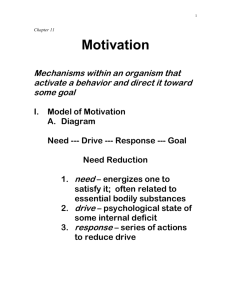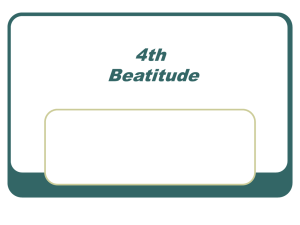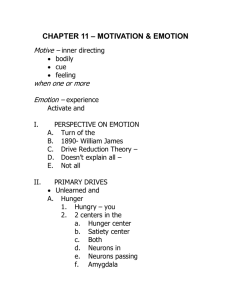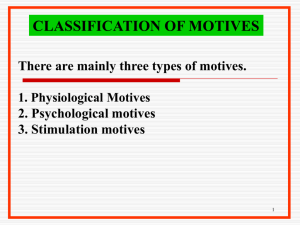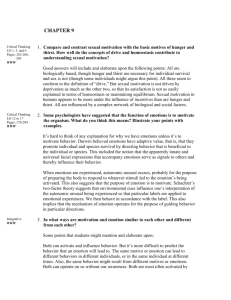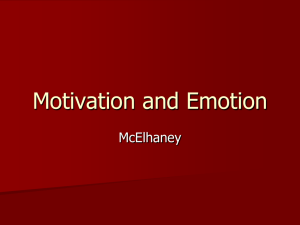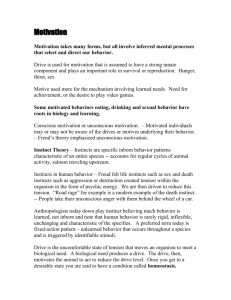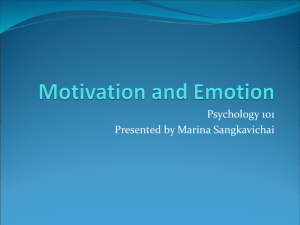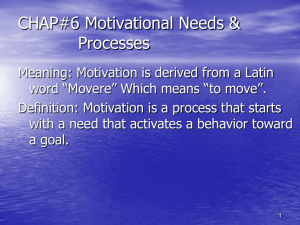Motivation
advertisement
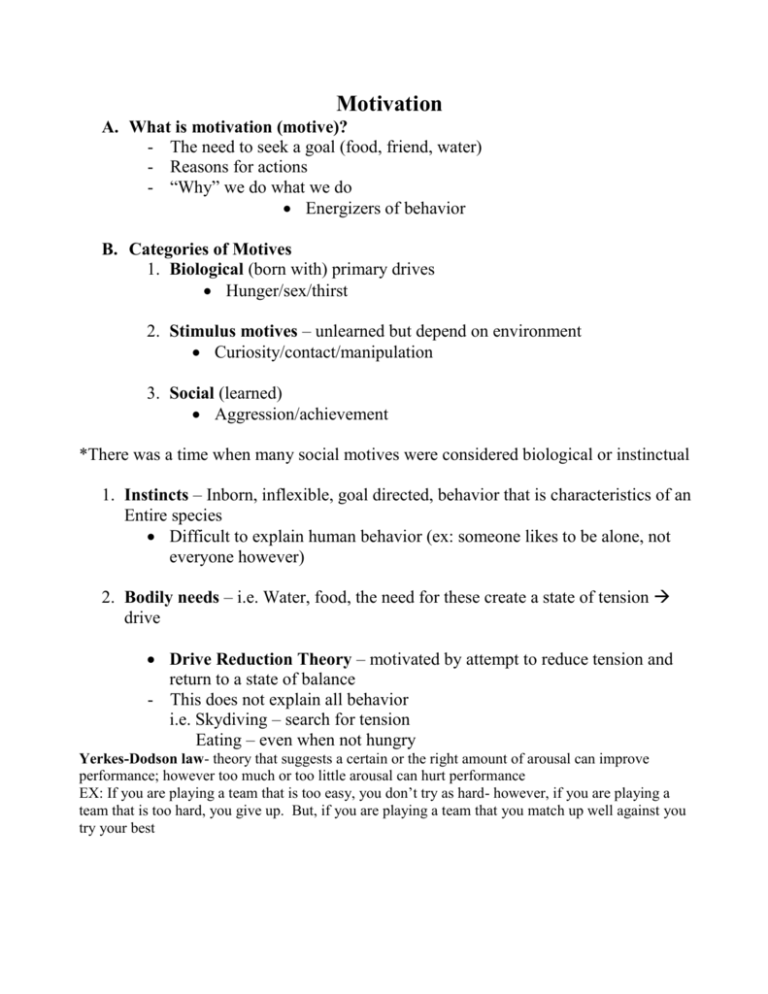
Motivation A. What is motivation (motive)? - The need to seek a goal (food, friend, water) - Reasons for actions - “Why” we do what we do Energizers of behavior B. Categories of Motives 1. Biological (born with) primary drives Hunger/sex/thirst 2. Stimulus motives – unlearned but depend on environment Curiosity/contact/manipulation 3. Social (learned) Aggression/achievement *There was a time when many social motives were considered biological or instinctual 1. Instincts – Inborn, inflexible, goal directed, behavior that is characteristics of an Entire species Difficult to explain human behavior (ex: someone likes to be alone, not everyone however) 2. Bodily needs – i.e. Water, food, the need for these create a state of tension drive Drive Reduction Theory – motivated by attempt to reduce tension and return to a state of balance - This does not explain all behavior i.e. Skydiving – search for tension Eating – even when not hungry Yerkes-Dodson law- theory that suggests a certain or the right amount of arousal can improve performance; however too much or too little arousal can hurt performance EX: If you are playing a team that is too easy, you don’t try as hard- however, if you are playing a team that is too hard, you give up. But, if you are playing a team that you match up well against you try your best Optimum arousal theory People are motivated to maintain a certain degree or optimum (ideal) level of arousal (excitement) If you have boring day, then you might want to do something more exciting at night. A fun, exciting night will make up for the boring day- or balance it out. EX: If someone were to ask you, “Why are we suddenly going to this party tonight?” According the optimum arousal theory, you would respond, “because I had a boring day and I need to get out and do something.” 3. Incentives – Goal directed behavior is based on incentives (rewards) Extrinsic motivation- motivation is based on attaining desirable, external or factors EX: Money and extra credit are examples of extrinsic motivation, which means you need something “extra” to perform the behavior. Intrinsic motivation- motivation is based on attaining personal satisfaction, or fulfilling personal reasons and needs EX: Some people run to beat other runners (extrinsic), while others compete to beat their previous best time (intrinsic). With all motives there is some stimulus… Stimulus (triggers) motive (triggers) behavior *Stimulus may be hunger or a commercial Biological/Primary Drives Unlearned – common to every animal Hunger, thirst, sex (all associated with survival of the organism or species) Hunger What causes us to “feel” hungry? 1. stomach contractions…but that is not all…in some rats they removed the stomach, and they were still hungry…found the same results in people whose ulcerated or cancerous stomach has been removed 2. the brain measures the amount of glucose in your blood…glucose levels drop…triggers hunger 2 centers in the Hypothalamus 1. lateral hypothalamus stimulates eating Monitors sugar in blood 2. ventromedial hypothalamus Reduce hunger But…hunger is influenced by Environment (smell, sight) Emotions (depressed) Social motives (date) (all started biologically, not much more, even cultural) Thirst and sex have also moved from being a strictly biological motive to being influenced by the environment. Thirst summertime – Lemonade Sex perfume, movie Stimulus Motives - Unlearned BUT dependent on the environment and external cues, not as important for survival *Exploration/Curiosity All animals/humans - Where does the road go? - Finding out more info *Manipulation Humans/Primates - Need fingers - Very difficult to NOT TOUCH - Finding out about an object - Also soothing stress (fidget, active) *Contact = the need to touch others Harry Harlow – studied monkeys - Monkeys had surrogate mothers - With Food – Wire - With Terry Cloth – No Food (both warm) - Monkey would pick terry cloth, even to the point of starvation if allowed Social Motives TAT (Thematic Apperception Test) - projective personality test - shown picture tell the story - unconsciously include info about self 1) Aggression – behavior intended to inflict harm on someone or something Freud innate drive reduction Most believe learned from models Usually a result of frustration or an unpleasant situation 1. Kulik and Brown → phone solicitation → 2 groups → expectations lead to aggression 2. told to wait in a room → hot, odor, smoke → lead to aggression 2) Dominance/Power – Influence or control of others Engage in behavior that affects others Interest in reputation Interest in position TAT (Thematic Apperception Test) themes i. Action, behavior that affects others, interest in reputation, interest in position *Some people with these motives become teachers, psychologists, executives in business, etc 3) Affiliation – from friendships/associations We like team goals Anxious without social contacts Make affiliations with some gain in mind Schachter = 2 groups → eclectic shock → A = expect pain from scary guy = w/people→ B = tickle from normal guy = alone 4) Achievement – David McClelland – TAT (Thematic Apperception Test) themes Excellence High standard of performance Unique accomplishments Pursuit of long-term goals Three aspects of achievement 1) Work – hard/good job 2) Mastery – difficult/challenging = improvement 3) Competitiveness – pitting skills Characteristics of High Achievers Good Fast learners Self-confident Energetic High Standards Responsible Resist pressure Bad Ulcers Not artistic Do not value intimate relationships Prefer experts to friendly people Headaches *Most studies were done on men Horner (1970) – Study done to see how men/women see a woman’s drive to succeed ``After first-term finals, Anne/John finds herself/himself at the top of her medical school class.'' Subjects were asked to write a story about the student 90% men wrote about success/65% women wrote about doom Overall, study found that women saw success as masculine not a feminine trait Maslow’s Hierarchy of Needs Maslow – Humanist -> believe each person is basically good and has the freedom in directing his or her future in achieving personal growth Humanist movement was a reaction to the negative views of humanity (Freud & Skinner) Maslow emphasized all human beings need to feel competent, win approval and recognition, and feel like they achieved something 3 Categories of needs Fundamental needs – have to satisfy in order to live Psychological needs – can only be filled by an outside source Self-actualized needs – all people have these needs however only a few actually reach this level 1) Physiological needs - to satisfy hunger, thirst and sex drives Basic needs of air, water, food, sleep, sex 2) Safety needs – to feel secure, safe and out of danger Establishing safety in a chaotic world 3) Belongingness and love needs – to affiliate with others; to be accepted and belong Belong to groups clubs, work groups, religious organizations, family, gangs, etc Need to feel loved (non-sexual) and accepted by others 4) Esteem needs – to achieve, be competent, gain approval and recognition Want admiration to feel powerful, desire interest from others regarding personal achievements 5) The need to fulfill one’s unique potential – i.e. pursuit of knowledge, peace, self-fulfillment, oneness with God, etc. Take up environmental causes, join the Peace Corps, volunteer service, go to a monastery *One stays in each level until needs are completely fulfilled *Achieving one level of needs, releases (or creates) new needs and motivations Industrial/Organization Psychology Industrial-organizational psychologists apply psychological concepts to the workplace in order to improve productivity and performance among workers Personnel psychology is a subfield of I/O psychology that focuses on employee recruitment, selection, training and development Organizational psychology is a subfield of I/O psychology that focuses on worker satisfaction and productivity Theory X suggests that workers are basically lazy and need to be extrinsically motivated Example: An example of theory X would be employers who offer bonuses as a way to improve employee performance Theory Y assumes that workers need to be challenged and as a result intrinsically motivated Example: An example of theory Y would be employers who give employees more responsibility in order for them to feel better about their role in the company


